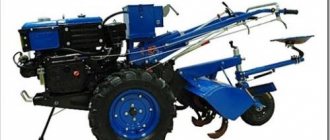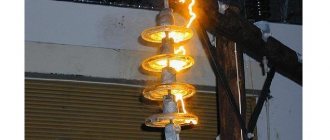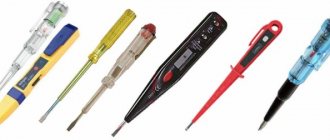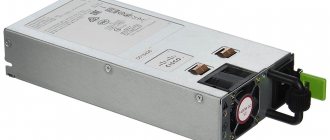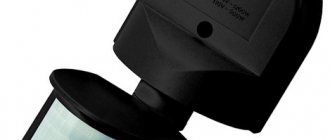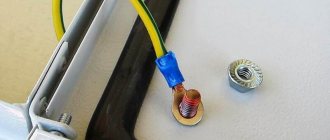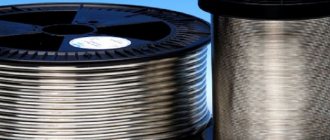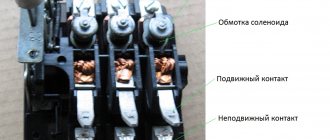Characteristics of insulators
An electrical insulator is a product designed to secure a wire, cable or busbar to the supporting structure of a power line and prevent it from breaking down to ground. They come in different types and are made from dielectric materials - porcelain, glass and polymers.
Since the electrical purpose of insulators is to insulate the conductor from the supporting structure, the main characteristics are:
- Dry discharge voltage is the voltage at which a spark discharge occurs across a surface in its dry state under normal environmental conditions.
- Wet discharge voltage is the same, but in the rain, if its jets hit the insulator at an angle of 45 degrees. The rain force is 5 mm/min, the specific volumetric resistance of water is 9500-10500 Ohm*cm (at 20°C). Since water conducts electric current, the wet-discharge voltage is always lower than the dry-discharge voltage.
- Breakdown voltage is the voltage at which breakdown of the insulator body between the rod and the cap occurs (for suspended products). The rod and cap are electrodes.
Designations of insulators
The labeling of each product contains information about its type, material and other characteristics. Look at an example of marking for insulator NSPKr 120 - 3/0.6 - B.
- The first letter N indicates the purpose of the model, in this case N - tension. It can also be K - console, F - fixed, P - suspended.
- C - indicates that this is a rod insulator.
- P is an insulating material, in this case P is a polymer.
- K – outer coating, in this case silicone rubber.
- p – index indicating that the protective shell is ribbed and solid.
- 120 is an indicator of the normalized breaking force in kN.
- 3 – voltage class of overhead line wires for which it is used.
- 0.6 – indicates the length of the leakage current path, measured in meters.
- B - indicates the type of engagement.
Design
Structurally, all electrical insulators differ in the methods of attachment to the supporting structure and cable fastening. The main task of this product is to prevent electrical discharges; for this purpose, they are made in the form of plates or rods with ribs. These ribs are needed so that the discharge develops at an angle to the field lines. In the figure below you see examples of typical products of different shapes and designs:
Hanging
used on overhead lines with a voltage of 35 kV and above. They consist of a porcelain or glass insulating part, a ductile iron cap, a metal rod and a cement bond. Suspended insulators are assembled into garlands, which can be either supporting (on intermediate supports) or tensioning (on anchor supports). The number of insulators in the garland is determined by the line voltage; 35 kV – 3-4 insulators, 110 kV – 6-8. Gradually, heavy glass garlands are being replaced by insulators made of polymer materials. They are a rod element made of fiberglass, on which a protective coating with ribs made of fluoroplastic or silicone rubber is placed.
| SUSPENDED | ||||
| normal execution | with increased rib extension | with double rib | special execution | polymer |
| PS-40, PS-40A, PS-70E, PS-120B, PS-160D, PS-210V, PS-300V | PSV-40V, PSV-120B, PSV-160A, PSV-210A | PSD-70E | PSS 120B, PSS 210B, PSK 300A |
|
Difference in material
To consider the classification of types and types of insulators, you must first understand how they are distinguished. So, first of all, they are classified according to the material of manufacture:
- Porcelain.
- Glass.
- Polymer.
Porcelain ones can be called classics; they were used before even for external wiring in houses. They are usually white, but can come in other colors. These can be seen on various electrical installations. The advantage is that they withstand high compressive loads and have good dielectric properties.
However, they break and break. Hence the need arises to regularly check their integrity, and often this requires turning off the electrical installation and wiping off oil, dust and other contaminants. Another problem is their heavy weight.
Glass ones, although they are afraid of shocks, but to control their integrity a visual inspection is sufficient, which can be carried out without turning off the voltage. Currently, they are replacing ceramics in overhead power lines and as suspension insulators, including because they weigh less and are also cheaper to produce.
Polymer ones are used indoors, rarely outdoors, as an exception. You can sometimes see support insulators made of polymers on 10 kV overhead lines or other medium voltages, but rarely, or on non-critical lines. This is due to the fact that over time and under the influence of UV radiation they age, the internal structure disintegrates and their electrical and mechanical characteristics deteriorate.
However, for equipment that is available for regular maintenance and repair, they are often used. For example, these can be busbar support insulators in transformer substations and distributors.
How do power line insulators work?
Power line insulator is a device for hanging and insulating wires on supports when laying an overhead power line (OHL). An insulator is a critical element of an overhead power line that simultaneously performs a fastening and protective function. The safety of installation and reliability of operation of overhead power lines depends on the correct choice and quality of the dielectric device.
In this article we will talk about the types and design of linear insulators, their designation and scope of application.
Classification of insulators according to the method of fastening to the support
According to the method of fixation on the support, insulators are divided into:
- Pin insulators - are attached to the traverses of the supporting elements using metal pins. Such insulators are used on overhead lines with voltages up to 35 kV. Depending on the type and configuration, pin insulators can be installed on overhead lines with bare and protected wires.
- Suspended insulators - used on power lines with a voltage of 35 kV or more for fastening medium and large cross-section wires using the suspension method. Suspended disc-type insulators are sequentially combined into garlands, and the number of devices involved is selected depending on the operating voltage of the line.
- Linear support insulators - designed for fastening and insulating unprotected and insulated wires. They are used on overhead lines with voltages up to 154 kV. The support insulators are attached to the traverses by means of a bolted connection.
Basic materials of insulators
Porcelain, glass and polymer materials are used to make insulators.
Porcelain (ceramic) insulators are made from special electrical silicate porcelain, which contains clay (kaolin), quartz and feldspar. The products are coated with a thick layer of glassy glaze and then fired in ovens. Electrical porcelain has high dielectric strength and excellent heat resistance. For more than 100 years, porcelain has been used to make insulators for overhead lines.
Electrical (electrical insulating) glass is a material characterized by high electrical resistivity, high dielectric and mechanical strength, and low dielectric losses.
Polymer (composite) insulators are cast from special composites. This material is several times lighter than glass and porcelain, which makes it more convenient to transport and install. At the same time, polymer insulators are less durable, since the material is destroyed under the influence of ultraviolet and solar radiation.
Arrangement of pin insulators
Pin insulators have been and remain a key insulating element on overhead power lines. The design of such a device is extremely simple. In the classic design, pin insulators are a monolithic insulating body made of glass, porcelain or polymer material.
To install the insulator on a metal pin, a blind hole with thread is provided in its body. Installation of the insulator on the pin is carried out using special plastic caps. There are special grooves on the insulator head for fastening wires.
There are also more modern modifications of pin insulators, which are mounted on the pin by tightening the nut of the tightening clamp. Classic glass and ceramic insulators are still used, for the fixation of which tow and red lead are used.
Modern versions of pin insulators for insulated wires are equipped with a split rotating plastic sleeve in the upper part, which allows installation of the wire without unrolling rollers.
Installation of suspension insulators
The dielectric part of suspended insulators consists of porcelain or special tempered glass. Inside the insulating part there are metal parts (head) - a cap made of malleable cast iron and a steel rod. Special cement is used to connect the insulating body to metal reinforcement.
Suspended disc-type insulators are combined into garlands by series connection, which makes it possible to obtain garlands for the required rated voltage.
The use of disc-type insulators prevents the wire from falling to the ground in case of damage to the insulating body, since the mechanical strength of the entire garland is not compromised. For operation in conditions of increased environmental pollution, disc insulators have been developed that have a more complex shape of the insulating body. Such devices are characterized by increased discharge performance and increased creepage distance.
Construction of support insulators
The classic rod-type post insulator consists of a cylindrical porcelain body, inside of which there is a shaped nut for fastening to the crosspiece. The nut is fixed inside the insulating body (in its lower part) to cement. In the upper part, the porcelain is reinforced with a metal cap.
The discharge characteristics of an isolating device can be improved by introducing an internal screen that reduces the electric field strength. The role of such a screen is performed by metal elements of the internal fittings of the reinforcement.
Support insulators are distinguished by rated voltage and mechanical strength, since devices are subject to bending mechanical loads during operation.
Advantages of glass insulators
One of the key advantages of glass insulators is the transparency of the material. Thanks to this, it is possible to visually determine the presence/absence of hidden defects inside the insulating body.
The technical control department at the manufacturer checks each product for the absence of bubbles in the power head of the insulator (optical control).
Glass insulators are not subject to aging, they are not destroyed by ultraviolet radiation. Glass has zero water permeability.
If glass insulators fail, they can be identified visually when operating personnel walk around the power line.
Advantages of porcelain insulators
The advantages of electrical porcelain insulators include high heat resistance. Porcelain products can withstand several cycles of sudden temperature changes with a difference of 700℃. The material is resistant to ultraviolet and solar radiation. The high dielectric properties of electrical porcelain practically eliminate insulator breakdown.
